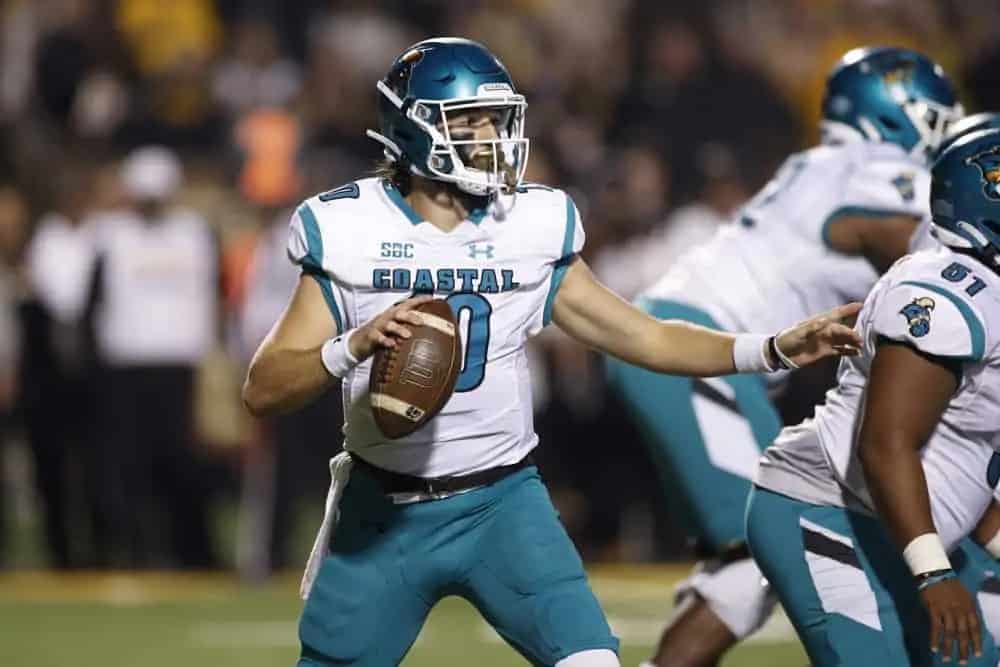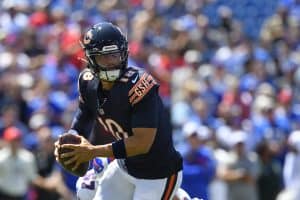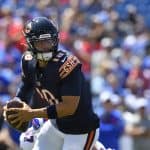The NFL is much friendlier for data nerds than college football. We have accessible advanced metrics like expected points added (EPA), and further, sacks aren’t recorded as negative rushing plays, allowing us to calculate net yards per attempt. In this installment of our NFL football sports betting and strategy guide, I’ll dive into the specifics of a useful alternative for college football: passing efficiency. If you want to zoom out and get a bigger-picture view, check out the first installment! As always, if you don’t want to do the dirty work yourself, subscribe to OddsShopper Insider Access and check out my NFL betting model. Let’s dig in!
This football betting guide tackles methods for developing an origination or projections-based football betting strategy. OddsShopper Premium’s tools take a different approach. Instead of using numbers to create a competing projection, OddsShopper indexes the lines available across the sportsbooks, especially the sharp ones, to identify bets with positive expected value. The method works for multiple different sports, including football, basketball, baseball and more. Want to give it a whirl? New users who sign up here can get 70% off their first month!
College Football Betting & Strategy Guide: What is Passing Efficiency?
College Football Betting & Strategy Guide Part 4. Passing Efficiency
Because the NCAA records sacks as negative rushing yards (dumb), I lean on passing efficiency when evaluating both quarterbacks and offenses. Passing efficiency rewards quarterbacks for throwing more completions, yards and touchdowns per attempt. It also punishes them for throwing interceptions. Let’s look at the formula:
Passing Efficiency = {(Completions * 100) + (Passing Yards * 8.4) + (Passing Touchdowns * 330) – (Interceptions * 200)} / Passing Attempts
The formula serves to reward quarterbacks for both accuracy and downfield aggression. Dink-and-dunk quarterbacks can fare well in the metric, but only if they successfully complete drives with touchdowns. Inaccurate big-arm quarterbacks can compensate for their interceptions the same way.
Of course, several factors beyond a quarterback’s control make passing efficiency a more useful metric for understanding offenses than individual quarterbacks themselves. A one-yard screen pass that goes for a 50-yard touchdown is worth the same as a 50-yard bomb to the end zone. Likewise, a tip-drill interception is worth the same as an errant throw into triple coverage. A drop is worth the same as a 10-yard overthrow.
It’s best to think of passing efficiency as a reflection of both the players on the field and the offensive scheme. Some teams routinely produce quarterbacks who grade well in the metric because their coaches emphasize moving the ball downfield quickly as opposed to grinding the clock. For example, from 2016 to 2019, Lincoln Riley’s Oklahoma Sooners produced a quarterback who ranked top 2 in the metric.
Using Passing Efficiency: Case Study | Football Betting & Strategy Guide
Passing efficiency is a valuable metric to consider both before the college football season starts and after it begins. Heading into last season, the top 5 quarterbacks in the metric for 2021 were all returning for another season. They were Grayson McCall (207.6), C.J. Stroud (186.6), Hendon Hooker (181.4), Stetson Bennett (176.7) and Caleb Williams (169.6).
Last season’s leaders in the metric look quite similar. They were Stroud (177.7), Hooker (175.5), McCall (171.4), Todd Centeio (169) and Williams (168.5). The only quarterback to fall out of that tier, Bennett (160.8), ranked a still-solid 11th. All five quarterbacks helped their schools go to bowl games, while four even made it to New Year’s Six Bowls. Two of them, Hooker and McCall, suffered serious injuries during the year.
Passing efficiency would have also helped us identify some teams that were likely to struggle. Clemson’s D.J. Uiagalelei, who was benched for Cade Klubnik and has since transferred to Oregon State, ranked 104th of 105 eligible quarterbacks in the metric at 108.7. Iowa’s Spencer Petras, now the likely backup to Michigan transfer Cade McNamara, recorded a 117.3. Although Uiagalelei made strides as a passer and ranked 63rd (135) last year, it wasn’t enough to keep his job. Petras stayed pat and ranked 100th (109.4).
Names to keep an eye on during the 2023 season include Tennessee’s Joe Milton III (204.3), who looked exceptional in a limited sample, Ohio’s Kurtis Rourke (167.7), who ran the MAC before getting hurt, and Arkansas’ K.J. Jefferson (164.9), who has been a top-10 performer in the metric each of the last two seasons. As fade as fade-worthy players go, new Bowling Green transfer Connor Bazelak (106.1) and Wyoming’s Andrew Peasley (105.9) stand out.
Using Passing Efficiency to Evaluate Offenses & Quarterbacks | Football Betting & Strategy Guide
Teams win football games by out-gaining and out-scoring their opponents. Passing efficiency is an interesting way to measure how teams do so on a per-play basis, and it’s a relatively stable metric on a year-to-year basis. It’s unlikely that players will dramatically change their passing efficiency mark without dramatically changing their game — or transferring to a team with a dramatically different scheme.
It’s easy to get wrapped up in limited stats like completion percentage and touchdowns, especially in college football, where our selection of statistics is generally more limited. However, passing efficiency gives us a pathway to one number that bakes in most available passing metrics, aside from quarterback rushing runs and fumbles.
Blindly backing the team with the more efficient quarterback isn’t always smart — for example, you wouldn’t take Coastal Carolina to beat Alabama just because Grayson McCall has a higher passing efficiency grade than Bryce Young. Defense is a meaningful part of the game, after all. However, trusting a team with an efficient quarterback to succeed over a long sample, like on a win total market, or go over their team total in an individual game, is generally a sharp strategy.
Index
Part 1. NFL & College Football Betting & Strategy Guide: Offense
Part 2. Expected Points Added (EPA)
Part 3. Net Yards Per Attempt (NY/A)
Part 4. Passing Efficiency
Part 5. NFL & College Football Betting & Strategy Guide: Defense (Coming Soon!)





























